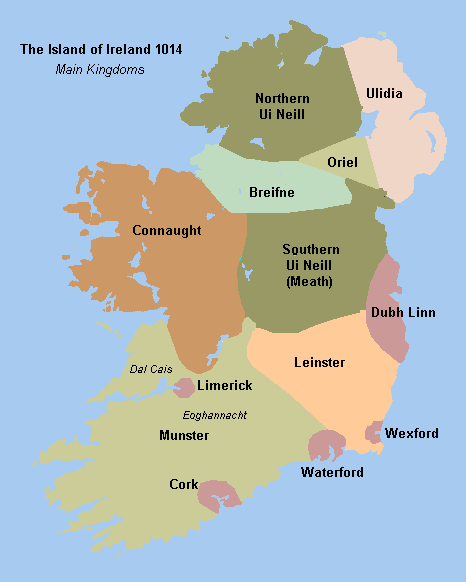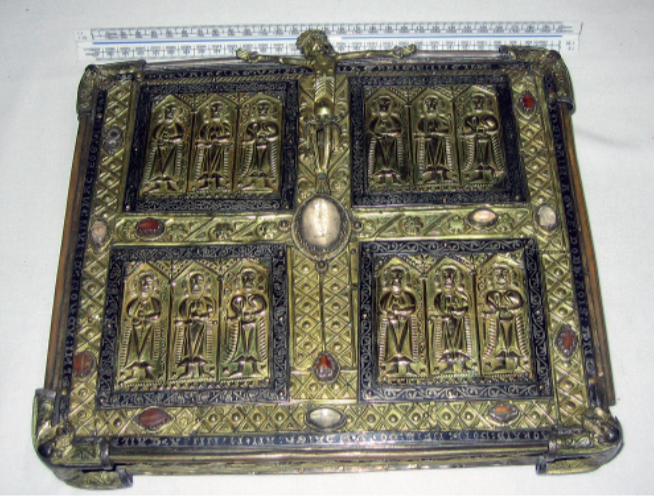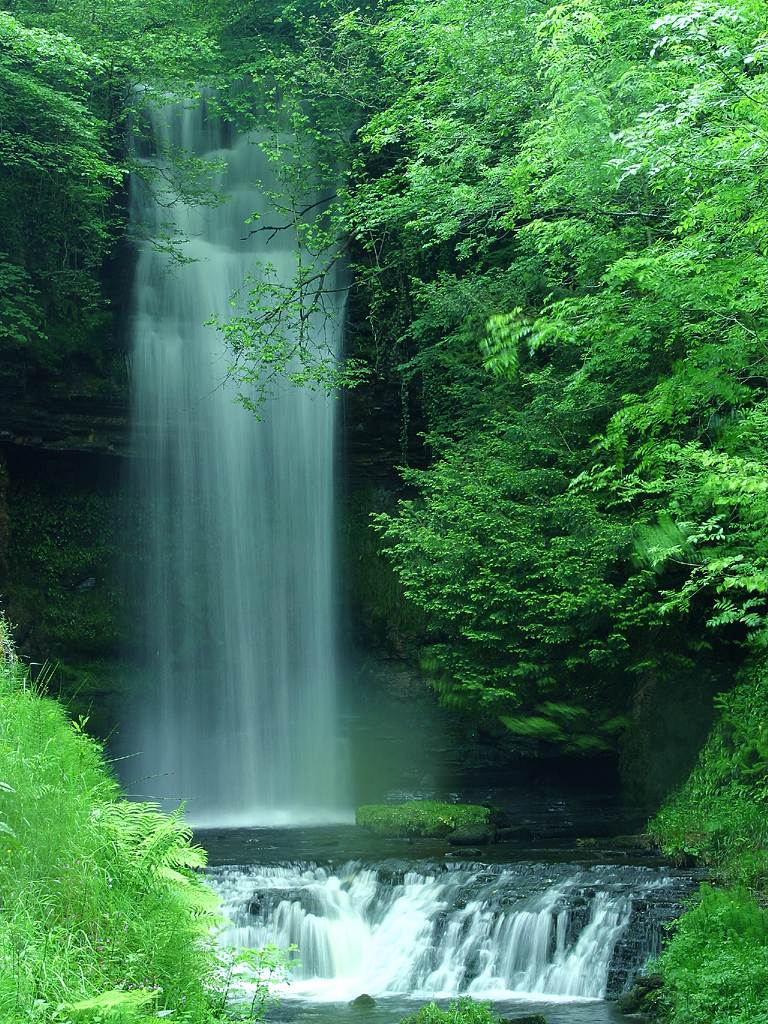|
Breifne
The Kingdom of Breifne or Bréifne (), anglicized as Breffny, was a medieval overkingdom in Gaelic Ireland. It comprised what is now County Leitrim, County Cavan and parts of neighbouring counties, and corresponds roughly to the Roman Catholic Diocese of Kilmore. It had emerged by the 10th century, as a confederation of ' headed by an overking drawn from the Uí Briúin Bréifne. By the 11th century, Bréifne was ruled by the Ua Ruairc (O'Rourke) dynasty. The kingdom reached the height of its power in the 12th century, under Tigernán Ua Ruairc. During the latter part of his reign, Bréifne took part in campaigns against the Norman invasion of Ireland. His assassination by the Anglo-Normans in 1172 was followed by a succession dispute, and a conflict between the Ua Ruairc and Ua Raghallaigh (O'Reilly) dynasties. Following the Battle of Magh Slecht in 1256, Bréifne split into West Breifne (ruled by the Ua Ruairc) and East Breifne (ruled by the Ua Raghallaigh). Bréif ... [...More Info...] [...Related Items...] OR: [Wikipedia] [Google] [Baidu] |
East Breifne
The Kingdom of East Breifne or Breifne O'Reilly (; , ) was an historic kingdom of Ireland roughly corresponding to County Cavan that existed from 1256 to 1607 in Ireland, 1607. It took its present boundaries in 1579 in Ireland, 1579 when East Breifne was renamed Cavan, after Cavan, Cavan town, and shired into Ulster. Originally part of the older Kingdom of Breifne, East Breifne came into existence following a protracted war between the ruling O'Rourke clan and the ascendant O'Reillys which culminated in the division of the kingdom in 1256. The Kingdom was ruled by the dynasty of the Ó Raghallaigh (O'Reilly) and lasted until the early 17th century. Origins and etymology The area of modern-day east County Cavan has been inhabited for over 5,000 years. The O'Reilly are descendant from a kin-group known as Uí Briúin, who settled the east Breifne area in the eighth century AD. At some point they splintered off from the Uí Briúin sept and became known as Muintir-Maelmordha, named ... [...More Info...] [...Related Items...] OR: [Wikipedia] [Google] [Baidu] |
West Breifne
The Kingdom of West Breifne (Irish: ''Breifne Ua Ruairc'') or Breifne O'Rourke was a historic kingdom of Ireland that existed from 1256 to 1605, located in the area that is now County Leitrim. It took its present boundaries in 1583 when West Breifne was shired and renamed Leitrim, after the village of Leitrim, County Leitrim, Leitrim, which was an O'Rourke stronghold. The kingdom came into existence after a battle between the ruling O'Rourke clan and the ascendant O'Reillys caused the breakup of the older Kingdom of Breifne and led to the formation of East Breifne and West Breifne. The kingdom was ruled by the O'Rourke clan and lasted until the early 17th century, when their lands were confiscated by Kingdom of England, England. Early history Formation In 1172, Tigernán Ua Ruairc, Tighearnán Ua Ruairc, the longtime Lord of Kingdom of Breifne, Breifne and Conmaice, was betrayed and killed at Tlachtgha during negotiations with Hugh de Lacy, Lord of Meath, Hugh de Lacy, Lord of ... [...More Info...] [...Related Items...] OR: [Wikipedia] [Google] [Baidu] |
Battle Of Magh Slecht
The Battle of Magh Slécht took place at Magh Slécht in Ireland in 1256. The battle was part of a wider conflict between the O'Rourke rulers of Breifne and their traditional O'Reilly vassals over control of the kingdom. Both sides were assisted by their respective allies, the O'Connor kings of Connacht and their Burke opponents. The battle marks the point at which the Kingdom of Breifne was left permanently divided, creating West Breifne (O'Rourke) and East Breifne (O'Reilly). Prelude Ally of the O'Reillys, Walter de Burgh, raided deep into Connacht and devastated the O'Connors. According to the Annals of Connacht, de Burgh had an army of 20,000 men, but this is most definitely exaggerated. This was followed by an O'Reilly attack in western Breifne (modern County Leitrim), the home territory of the O'Rourkes. The two armies were meant to rendezvous at Lough Allen but the O'Reillys came under heavy attack in the townland of Seltanahunshin, County Leitrim and retreated nor ... [...More Info...] [...Related Items...] OR: [Wikipedia] [Google] [Baidu] |
County Cavan
County Cavan ( ; ) is a Counties of Ireland, county in Republic of Ireland, Ireland. It is in the Provinces of Ireland, province of Ulster and is part of the Northern and Western Region. It is named after the town of Cavan and is based on the historic Gaelic Ireland, Gaelic territory of East Breifne, East Breffny (''Bréifne''). Cavan County Council is the Local government in the Republic of Ireland, local authority for the county, which had a population of 81,704 at the 2022 census. Geography Cavan borders six counties: County Leitrim, Leitrim to the west, County Fermanagh, Fermanagh to the north, County Monaghan, Monaghan to the north-east, County Meath, Meath to the south-east, County Longford, Longford to the south-west and County Westmeath, Westmeath to the south. Cavan shares a border with County Fermanagh in Northern Ireland. Cavan is the 19th largest of the 32 counties in area and the 25th largest by population. The county is part of the Northern and Western Region, a ... [...More Info...] [...Related Items...] OR: [Wikipedia] [Google] [Baidu] |
O'Rourke Arms
O'Rourke () is an Irish Gaelic clan based most prominently in what is today County Leitrim. The family were the historic rulers of Breifne and later West Breifne until the 17th century. The O'Rourke Clan Chief was at odds with the O'Reilly Chief because both clans contested each other for the title Prince of Breifne. Newerkla, Stefan Michael (2020), Das irische Geschlecht O'Reilly und seine Verbindungen zu Österreich und Russland he Irish O'Reilly family and their connections to Austria and Russia In: ''Diachronie – Ethnos – Tradition: Studien zur slawischen Sprachgeschichte iachrony – Ethnos – Tradition: Studies in Slavic Language History'' Eds. Jasmina Grković-Major, Natalia B. Korina, Stefan M. Newerkla, Fedor B. Poljakov, Svetlana M. Tolstaja. Brno, Tribun EU, pp. 259–27(accessible online) here pp. 263–265. The O'Rourke chief was seated at O'Rourke's Tower House which was on the north side of Lough Gill, County Leitrim, and which is now Parke's Castle. Nami ... [...More Info...] [...Related Items...] OR: [Wikipedia] [Google] [Baidu] |
Gaelic Ireland
Gaelic Ireland () was the Gaelic political and social order, and associated culture, that existed in Ireland from the late Prehistory of Ireland, prehistoric era until the 17th century. It comprised the whole island before Anglo-Norman invasion of Ireland, Anglo-Normans conquered parts of Ireland in the 1170s. Thereafter, it comprised that part of the country not under foreign dominion at a given time (i.e. the part beyond The Pale). For most of its history, Gaelic Ireland was a "patchwork" hierarchy of territories ruled by a hierarchy of kings or chiefs, who were chosen or elected through tanistry. Gaelic warfare, Warfare between List of Irish kingdoms, these territories was common. Traditionally, a powerful ruler was acknowledged as High King of Ireland. Society was made up of Irish clans, clans and, like the rest of History of Europe, Europe, was structured hierarchically according to Social class, class. Throughout this period, the economy was mainly Pastoralism, pastoral a ... [...More Info...] [...Related Items...] OR: [Wikipedia] [Google] [Baidu] |
O'Reilly
O'Reilly () is a common Irish surname. The O'Reillys were historically the kings of East Bréifne in what is today County Cavan. The clan were part of the Connachta's Uí Briúin Bréifne kindred and were closely related to the Ó Ruairc (O'Rourkes) of West Bréifne. O'Reilly is ranked tenth in the top twenty list of most common Irish surnames. It is also the patronymic form of the Irish name Reilly (). The name is commonly found throughout Ireland, with the greatest concentration of the surname found in County Cavan followed by Longford, Meath, Westmeath, Fermanagh and Monaghan, and the Province of Leinster. Naming conventions Overview Usually anglicised as Reilly, O'Reilly or Riley, the original form of the name, Ó Raghallaigh, denotes "descendant of Raghallach". The Ó Raghallaigh family were part of the Connachta, with the eponymous Raghallach said to have died at the Battle of Clontarf in 1014. The family became the kings of East Breifne, modern-day Coun ... [...More Info...] [...Related Items...] OR: [Wikipedia] [Google] [Baidu] |
Connacht
Connacht or Connaught ( ; or ), is the smallest of the four provinces of Ireland, situated in the west of Ireland. Until the ninth century it consisted of several independent major Gaelic kingdoms (Uí Fiachrach, Uí Briúin, Uí Maine, Conmhaícne, and Delbhna). Between the reigns of Conchobar mac Taidg Mór (died 882) and his descendant, Aedh mac Ruaidri Ó Conchobair (reigned 1228–33), it became a kingdom under the rule of the Uí Briúin Aí dynasty, whose ruling sept adopted the surname Ua Conchobair. At its greatest extent, it incorporated the often independent Kingdom of Breifne, as well as vassalage from the lordships of western Mide and west Leinster. Two of its greatest kings, Tairrdelbach Ua Conchobair (1088–1156) and his son Ruaidri Ua Conchobair (c. 1115–1198) greatly expanded the kingdom's dominance, so much so that both became High King of Ireland. The Kingdom of Connacht collapsed in the 1230s because of civil war within the royal dynasty, which enab ... [...More Info...] [...Related Items...] OR: [Wikipedia] [Google] [Baidu] |
Norman Invasion Of Ireland
The Anglo-Norman invasion of Ireland took place during the late 12th century, when Anglo-Normans gradually conquered and acquired large swathes of land in Ireland over which the monarchs of England then claimed sovereignty. The Anglo-Normans claimed the invasion was sanctioned by the papal bull '' Laudabiliter''. At the time, Gaelic Ireland was made up of several kingdoms, with a High King claiming lordship over most of the other kings. The Anglo-Norman invasion was a watershed in Ireland's history, marking the beginning of 800 years of British presence in Ireland. In May 1169, Anglo-Norman mercenaries landed in Ireland at the request of Diarmait mac Murchada (Dermot MacMurragh), the deposed King of Leinster, who sought their help in regaining his kingship. They achieved this within weeks and raided neighbouring kingdoms. This military intervention was sanctioned by King Henry II of England. In return, Diarmait had sworn loyalty to Henry and promised land to the Normans ... [...More Info...] [...Related Items...] OR: [Wikipedia] [Google] [Baidu] |
County Leitrim
County Leitrim ( ; ) is a Counties of Ireland, county in Republic of Ireland, Ireland. It is in the Provinces of Ireland, province of Connacht and is part of the Northern and Western Region. It is named after the village of Leitrim, County Leitrim, Leitrim. Leitrim County Council is the Local government in the Republic of Ireland, local authority for the county, which had a population of 35,199 according to the 2022 census of Ireland, 2022 census. The county was based on the Gaelic Ireland, Gaelic territory of West Breifne, West Breffny () as it existed in the 1580s. Geography Leitrim is the 26th in size of the 32 counties by area (21st of the 26 counties of the Republic) and the smallest by population. It is the smallest of Connacht's five counties in both size and population. Leitrim is bordered by the counties of County Donegal, Donegal to the north, County Fermanagh, Fermanagh to the north-east, County Cavan, Cavan to the east, County Longford, Longford to the south, Count ... [...More Info...] [...Related Items...] OR: [Wikipedia] [Google] [Baidu] |
Roman Catholic Diocese Of Kilmore
The Diocese of Kilmore (; ) is a Latin Church diocese which is mainly in the Republic of Ireland although a few parishes are in Northern Ireland. It is one of eight suffragan dioceses which are subject to the Metropolitan Archdiocese of Armagh.Archdiocese of Armagh Retrieved on 16 January 2009. On 29 June 2020, it was announced that Pope Francis had appointed Martin Hayes, a former priest of the Archdiocese of Cashel and Emly, as Bishop of Kilmore in succession to Philip Leo O'Reilly. He received episcopal ordination on 20 September 2020. Geography< ...
|






